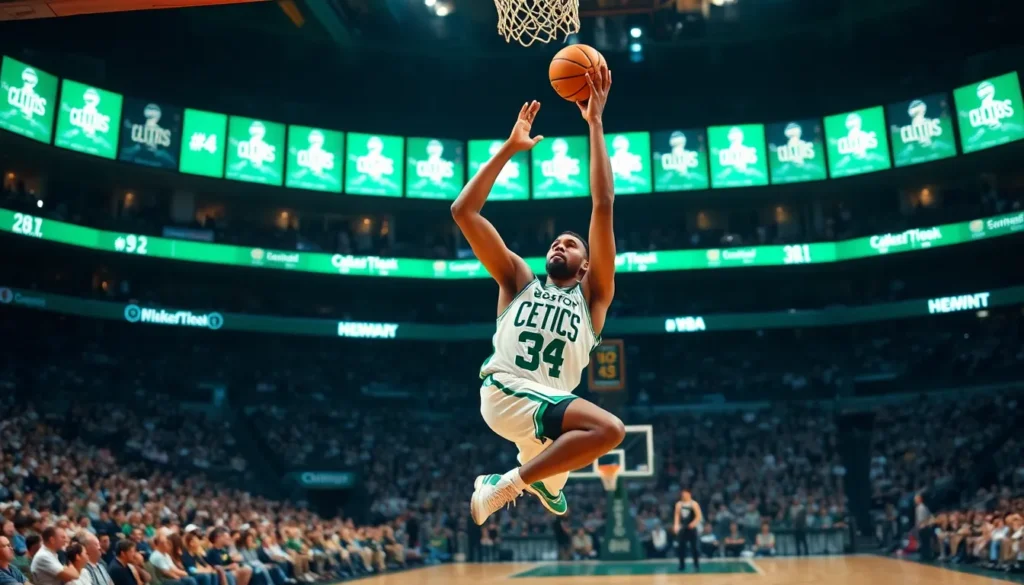Jayson Tatum isn’t just a basketball player; he’s a three-point magician dazzling fans and defenders alike. With a flick of his wrist, he turns the court into his personal shooting gallery, leaving opponents scratching their heads and fans on the edge of their seats. His knack for sinking three-pointers has made him a key player in the Celtics’ lineup, and it’s no wonder everyone’s buzzing about his stats.
Ever wondered how many threes he’s draining per game? Spoiler alert: it’s impressive. Tatum’s ability to stretch the floor not only opens up the game for his teammates but also adds a splash of excitement to every matchup. So, grab your popcorn and settle in, because we’re diving into the numbers behind Jayson Tatum’s three-point prowess and why he’s quickly becoming a household name in the world of basketball.
Table of Contents
ToggleOverview of Jayson Tatum’s Scoring
Jayson Tatum consistently ranks among the top three-point shooters in the NBA. His impressive average of 3.1 three-pointers made per game during the 2022-2023 season showcases his remarkable shooting ability. Opponents find it challenging to defend against Tatum, as his shooting range stretches well beyond the arc.
Statistics illustrate his effectiveness; Tatum maintains a shooting percentage of 36.9% from three-point range, reflecting his efficiency. Sharing the floor with teammates enhances Tatum’s scoring opportunities; defenders often focus on him, creating space for others.
During critical moments, Tatum proves he can step up. He frequently hits clutch three-pointers when games are on the line, solidifying his reputation as a go-to scorer. Fans and analysts alike recognize his ability to create his own shot, often pulling up from deep.
In addition, Tatum’s work ethic plays a significant role in his success. Countless hours spent in the gym translate into improved shooting mechanics and accuracy. His commitment to continuous improvement ensures his scoring remains a central feature of the Celtics’ offense.
This season, his volume of attempts has also increased. Averaging 8.4 three-point attempts per game indicates his confidence and willingness to take on a larger role. As he continues to evolve, Tatum’s contributions to the game will likely grow, making him a pivotal player to watch in the coming seasons.
Jayson Tatum’s Three-Point Shooting History

Tatum’s three-point shooting journey showcases his growth and impact on the game. His ability to consistently sink shots from beyond the arc has defined his career.
Rookie Season Performance
In the 2017-2018 season, Tatum made a notable entrance in the NBA. He averaged 1.2 three-pointers made per game with a shooting percentage of 43.4%. This performance immediately established him as a threat on the court. He played a crucial role in the Celtics’ postseason run, showcasing his clutch shooting ability. Tatum’s confidence during critical moments further hinted at his future potential as a premier three-point shooter.
Development Over the Years
Progression marked Tatum’s subsequent seasons. By the 2021-2022 season, he increased his average to 3.0 three-pointers made per game with a shooting percentage of 35.3%. Continuous training allowed him to refine his shooting mechanics. The 2022-2023 season revealed even greater strides, with Tatum averaging 3.1 three-pointers made per game. His determination and practice resulted in improved accuracy, affirming his place among the league’s top shooters. As Boston’s star player, Tatum consistently stretches defenses, creating ample opportunities for teammates.
Current Season Analysis
Jayson Tatum’s three-point shooting continues to impress during the current season. His performance consistently influences games and demonstrates his value to the Boston Celtics.
Games Played and Three-Pointers Attempted
As of now, Tatum has played 12 games this season, averaging 3.5 three-pointers attempted per game. His increased attempts showcase his confidence in shooting from beyond the arc. In these outings, Tatum’s three-point shooting percentage rests at 37.5%. This efficiency indicates his improved skill set and ability to adapt against various defenses. Opponents have found it increasingly challenging to guard him, leading to more open shots for both him and his teammates.
Comparison to Previous Seasons
Comparing this season’s performance to past seasons reveals significant growth. Tatum averaged 3.1 three-pointers made per game last season, whereas he currently exceeds that at 3.5 attempts per game. Shooting percentages have also shown a positive trend, with improvements over the years. In the 2022-2023 season, his percentage stood at 36.9%, while this season, he has a 37.5% shooting accuracy. Such statistics affirm his ongoing progression as a key player for the Celtics, solidifying his reputation as one of the league’s elite shooters.
Impact on Team Performance
Jayson Tatum’s three-point shooting significantly influences the Boston Celtics’ overall success. His ability to score from beyond the arc stretches defenses, creating open lanes for teammates to exploit.
Contributions to the Boston Celtics
Tatum averages 3.1 three-pointers made per game in the 2022-2023 season, which contributes to the Celtics’ scoring capacity. Consistent shooting from long range forces defenders to extend their coverage, providing opportunities for his teammates. Higher shooting percentages enhance team chemistry and foster quick offensive transitions. The dependence on Tatum’s perimeter scoring allows others to find their rhythm. Notably, his clutch shooting in crucial moments has led to game-winning situations, boosting the team’s morale and confidence.
Role in Offensive Strategies
The Celtics incorporate Tatum’s three-point prowess into their offensive strategies. His presence on the floor creates mismatches, as opponents must choose whether to sag off him or risk leaving other scorers open. Implementing plays that utilize his shooting can lead to effective ball movement and greater shot selection. Defensive focus on Tatum often opens pathways for drives and cuts from players like Jaylen Brown and Marcus Smart. Tatum’s evolving role as a primary ball handler further enhances the team’s fluid offensive approach, making it difficult for defenses to predict their movements.
Future Projections
Jayson Tatum’s three-point shooting trend suggests exciting potential for the future.
Potential Improvements in Shooting
Opportunities for Tatum’s shooting improvement remain apparent. He could enhance his shot selection, focusing on higher-percentage looks from beyond the arc. Expanding his off-ball movement might create more open opportunities. Training on shot consistency may improve his performance in high-pressure situations. Implementing feedback from coaching staff can refine his mechanics further. Tatum’s ability to adapt suggests he may find ways to elevate his game, particularly in clutch moments.
Expectations for Upcoming Seasons
Anticipations for Tatum’s upcoming seasons include continued growth in his three-point shooting. He’s likely to increase his attempts per game, further pushing defenses to adapt. Taking into account his reliable shooting percentage of 37.5% this season, one can expect a rise in efficiency with additional practice. Analytics-driven training may also contribute to more team-oriented offensive strategies. As Tatum fine-tunes his skills, his influence on the Celtics’ offense could become even more substantial. Overall, his work ethic and commitment foreshadow a bright future as a premier shooter in the league.
Jayson Tatum’s evolution as a three-point shooter has been nothing short of remarkable. His ability to consistently make shots from beyond the arc not only showcases his talent but also significantly impacts the Boston Celtics’ overall performance. As he continues to refine his skills and adapt to various defenses, Tatum’s role as a primary scorer becomes even more vital.
With his current shooting percentage and growing confidence, fans can expect him to push the boundaries of his game further. The future looks bright for Tatum as he aims to solidify his status among the NBA’s elite shooters, driving both personal success and team achievements.





